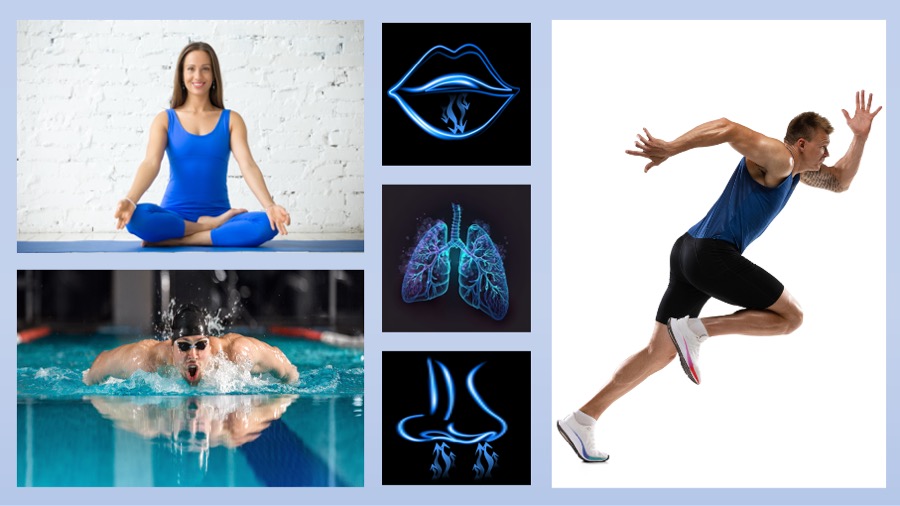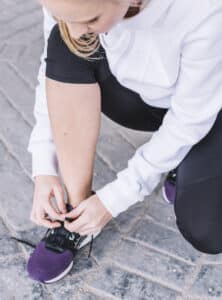
Sport breathing in your aquafitness classes: aquagym and aquabike
An often neglected but essential element of sport, and more specifically with regard to our function as a coach for the courses: aquabike, aquagym and aquafitness:
sports breathing plays a key role in optimizing performance
Yet, strangely, it is frequently forgotten in our training curricula.
It can be compared to a car manufacturer neglecting the fuel supply to the engine – no matter how powerful and advanced his cars are, without a good fuel supply they will not run optimally!
The importance of a good sports breathing method should not be underestimated. Especially when engaging in sports activities – in this case, our respective courses such as aquabike, aquafitness or water aerobics.
With good breath control, you can reach your full potential, regardless of the type or intensity level of the exercise blocks you choose.
And that, without overexertion, which is the enemy of progress!
Which can be detrimental to your heart activity.
Whether you’re warming up or pushing your performance to the max, proper breathing is essential.
Today, we are going to explore how to best regulate our breathing according to the intensity of the effort to be made.
Let’s start with a little review, which by the way, is part of our training curriculum in the category: physiology!

Inspiratory process or inhalation:
During inspiration, our lungs expand and fill with oxygen-rich air thanks to the action of our vital organs.
This expansion is facilitated by the contraction of the diaphragm, which moves downward while relaxing the abdominal muscles to make room for a larger breathing volume.
Simultaneously, the expansion of the intercostal muscles increases the volume of the lungs.
Finally, this inhalation allows the oxygen molecules contained in the air particles to enter the body’s cells.
They are transformed into energy – a process known as cellular respiration – generating ATP (Adenosine Triphosphate).
As a result, less O2 and a reduction in ATP and therefore performance.
Process of expiration or exhalation:
When we exhale, the diaphragm and intercostal muscles relax, allowing air to be expelled from our lungs.
Simultaneously, when we exhale through the nose and/or mouth, our abdominal muscles contract, exerting pressure that pushes the diaphragm upward for maximum efficiency in releasing carbon dioxide into the atmosphere!
A poor exhalation will thus reduce inhalation performance.
Good to know:
Breathe Less – Against the Beliefs of Sports Respiration -.
Athletes can increase their performance by reducing the number of breaths.
Excessive breathing releases too much carbon dioxide and impairs the delivery of oxygen to working muscles, yet people often assume that faster breathing provides extra oxygen when our bodies are already near capacity. This is why it is beneficial for athletes to intentionally reduce their breathing rate – it leads to better performance!
The athletic breathing stages can be classified into 4 distinct groups, each with its own characteristics:
Slow effort, moderate effort, intense effort and recovery.
– At slow and moderate effort, inspiratory and expiratory times gradually balance out (50/50) as the intensity increases.
In addition, normal breathing (on a daily basis) is done preferentially through the nose, then through the nose and mouth when shortness of breath increases, during more intense physical effort.
Why prefer breathing in through the nose (when you can):

–
Breathing through the nose, allows absorbing a healthier air (vibrissae, mucus…)
-Breathing through the nose allows you to calm down and increases your concentration, especially outside a sporting context.
Nasal breathing regulates blood pressure and heart rate by a mechanical process. The narrowness of the sinuses causes an increase in lung pressure.
The result is more time for the lungs to process the passing air and extract as much oxygen as possible. Having a balanced ratio of oxygen to oxygen in the blood keeps the pH constant.
However, the more the effort increases, the more difficult it is to carry out a nasal type of breathing, which then requires on an intense effort an additional energy and a longer duration of filling the lungs.
So if you are making a very intense effort like aquabike, pedal at a rate of 160 BPM for two minutes, blocks repeated by 3.
Nasal breathing will quickly lead to an oxygen deficiency based on immediate needs. Therefore, the inhalation will be oral for a much faster inspiration.
For example, in swimming, it is difficult to breathe in through the nose during a crawl or a butterfly.
Note that I am not comparing swimming breathing to land sports, but rather the optimization of inspiration over a minimum time. It is the same for sprinting.
The stages of sports breathing:
Easy effort:
Inhale through the nose and exhale through the mouth 50/50 (corresponds to the time of inspiration and expiration)
Moderate effort:

According to the endurance of the practitioner:
Generally, a 50/50 split of breathing should be involved with inhalation through the mouth and nose and exhalation through the mouth.
This approach optimizes airflow volume and oxygen delivery to meet physical demands while avoiding overexertion – thus maintaining stable heart rate levels for safety.
The intensity exerted can be measured by post-workout recovery tests that assess both cardiac and respiratory capabilities to better understand performance outcomes.
Not all your audience has a connected watch to know their heart rate zones (aerobic and anaerobic thresholds…).
And you, do you know your threshold?
Intense Effort: Sprinters’ Breathing:
Mouth breathing may not be an attractive feature, but it proves invaluable for sprinters or tabata phases.
This is due to the increased oxygen intake that results from breathing in through the mouth and nose simultaneously.
Thus, a forced exhalation facilitates abdominal contraction as well as muscular explosiveness.
At the end of the exhalation, the inspiration will also be faster thanks to the “depression” of the lungs.
In this context, we keep as much as possible a muscular and respiratory dynamic over a given duration very intense.
Thus avoiding apnea, to prolong the effort at high intensity.
At rest :

At rest, inhalation is generally shorter than exhalation (40% versus 60% of the respiratory cycle).
Deep abdominal breathing is defined as a slow, deep inhalation through the nose, using the diaphragm, with minimal movement of the chest.
This breathing technique and very common in Pranayama Yoga, Zen and meditation.
Exercise:
Focus on engaging your diaphragm as you breathe. To check if this is the case, place one hand on your belly and the other on your chest – when you breathe in nasally, deeply, with each breath, only the abdominal hand should move.
By breathing this way, you create more space for our diaphragm rather than relying solely on the limited lung capacity of chest breathing.
You increase the volume of air inhaled.
If your shoulders are moving during your exercise, then you are more likely to be on chest breathing.
In fact, there are many other breathing techniques.
For example, square breathing: 4 – 4 – 4 – 4 (4 corresponds to the seconds on four actions: Inhale, block, exhale, block).
It regulates the heartbeat, systole and diastole, doesn’t it remind you of anything?
Or the return to calm by regulating the body: 4 – 6 (seconds on two actions: inhale and exhale).
Chapter available in the downloadable PDF: Good coach: 10 tips.
In short, many other breathing techniques have existed for thousands of years through Buddhism and Ayurvedic or Chinese medicine.
Topics widely available on the web both in terms of breathing time and optimization of the respiratory muscles.
Conclusion:

As a coach, it is our responsibility to ensure that our participants learn the necessary techniques that will help them to make an optimal effort and thus create lasting sports habits.
Or basic information that will help them in their daily life.
We need to arm ourselves with knowledge and share it so that others can benefit.
As part of this “mission”, I highly recommend that you refer to Chapter 9 “A Good Coach: The 10 Tips”, which can be downloaded for free.
Where testing one’s teaching guidelines is essential!
Everyone’s physical abilities are influenced by many factors such as age and gender, probably your audience will make the effort to find out more!
The reward of this work is a strong link with your professional competence and the fact that practitioners will be able to look for additional or more advanced information, or even pass on their new knowledge to their entourage (children, grandson, etc.)!
In any case, we have contributed to sow the seeds on the subject; it is now up to them to raise their level of competence… Or not!
Thank you for reading.
Coach Aqua: The blog

Leave a Reply Cancel reply
You must be logged in to post a comment.





